The Flying Dutchman is the mythic tale of a ghost ship that
was eternally doomed to roam the seas after foundering in a
gale off the Cape of Good Hope. The story was first recorded
in print in the 1790s but it probably dates back to the 17th
century era of Dutch maritime glory. In Scotsman John
Howison's 1821 short story "Vanderdecken's Message Home; or,
the Tenacity of Natural Affection," a captain named Hendrick
Vanderdecken refuses the chance to shelter in Cape Town's
Table Bay after struggling all day to tack past strong
contrary winds: "May I be eternally damned if I do, though I
should beat about here till the day of judgment." According to
most versions of the story, sailors around the globe catch
glimpses of the unlucky ship from time to time, and it is an
ill omen. Countless short stories, novels, poems, stage plays,
operas, songs, video games, and movies have drawn on this
myth, from Coleridge's Rime of the Ancient Mariner to
Disney's Pirates of the Caribbean.
In 1840-41 Richard Wagner wrote the libretto and score of Der
fliegende Holländer, which many lovers of his music,
affirming the composer's own opinion, consider the first of
his mature operas. Wagner was inspired by an 1834 Heinrich
Heine tale which made the captain of the ship a kind of
wandering Jew, cursed by the devil to sail the seas endlessly
because he had committed blasphemy, but with the sarcastic
proviso that he could be saved by the love of a faithful wife
(an unlikely possibility, in the devil's view). Wagner made
this challenge the motive of his plot. Some of the opera's
action takes place in Norway, reflecting the impact of a
difficult sea crossing that the composer made from Riga to
London in 1839 with his wife Minna, in the course of which
their ship sheltered from bad weather in a Norwegian fjord.
In Wagner's libretto, a sea captain named Daland takes refuge
from a storm in southern Norway. At night a ghostly vessel
appears alongside his ship and grappling hooks bind the two
vessels together. A pale black-bearded man, dressed all in
black, comes aboard and tells Daland that he has been cursed
to roam the sea forever, but that every seven years a
heaven-sent wave casts him ashore, giving him a chance to find
a woman who will be faithful to him and release him from the
curse. Hearing that Daland has an unmarried daughter, he
offers the captain treasure from his ship for her hand. Daland
agrees, and the two set sail for Daland's home.
There the daughter, Senta, has been gazing on a picture of
the legendary Flying Dutchman and wishing that she could save
him. She discards her former boyfriend Erik, and when her
father arrives with her new betrothed she vows to be faithful
to him to the point of death. But the Dutchman later overhears
Erik complaining to Senta that she once swore to be true to him.
This news fills the mariner with despair and he resolves to
sail away once more. As his ship departs, Senta throws herself
from a cliff, repeating her vow of fidelity until death. The
curse is broken, the phantom ship disappears, and Senta and
the Dutchman ascend to heaven.
Thornton infers that when Bloom thinks of "Ludwig, alias
Ledwidge, when he occupied the boards of the Gaiety," he
is recalling a performance of Wagner's The Flying Dutchman.
It is tempting to assume that he is correct. Not only does
this operatic fable offer clear parallels to the story of a
Jew condemned to wander the earth eternally as punishment for
some blasphemy against the Christian religion, but it also
involves the wanderer in a domestic drama of sexual fidelity.
The Dutchman's dependence on a woman for his salvation, and
his uncertainty about whether he owns her heart given her
connection to another man, would seem to make him a perfect
analogue for Joyce's outcast protagonist—as useful as anything
in Homer, Shakespeare, or Mozart.
In The Case of Wagner, Friedrich Nietzsche laughed at
the composer's reliance on this trope: "Someone always wants
to be saved in his operas . . . If it were not for Wagner, who
would teach us . . . that even the eternal Jew gets saved and
settled down when he marries?"
In a well-researched article that quotes these sentences in a
footnote, "Joyce, Wagner, and the Wandering Jew," Comparative
Literature 42.1 (1990): 49-72, Timothy P. Martin
observes that Wagner saw himself as a Wandering Jew or Flying
Dutchman seeking sexual and artistic homecoming, and that the
young Joyce loved Wagner's mythmaking in general and the music
of Der fliegende Holländer in particular. Martin notes
many echoes of the opera's story in Joyce's works: in
"Eveline" a sailor woos a domestic woman and a domestic woman
waits for him; in A Portrait Stephen Dedalus is an
exiled wanderer seeking redemption in the love of a woman; in
Exiles Robert Hand longs to fall from a high cliff into
the sea and die in the arms of the woman he loves; in Proteus
and Aeolus Stephen's vampire
fantasy involves a deathly lover on a ghost ship coming
to kiss a woman; in Eumaeus the long-exiled mariner
drinks "Holland gin"; and in section II.3 of Finnegans Wake
the tailor has a daughter whom the wandering Norwegian captain
agrees to marry. Martin advances many other details in support
of his claim.
His wealth of evidence leaves little doubt that Joyce was
thinking of Wagner's Flying Dutchman from early in
his writing career until the end, but—alas for the search of
tidy answers—it seems unlikely that Bloom could be thinking
only or even primarily of this opera. Although it was one of
only two or three Wagner works performed in Dublin before
1940, according to Martin, it seems unlikely that 19th century
Dubliners would have made a "stupendous success" of
such an avant-garde performance, and even more unlikely that
Bloom in particular would get caught up in the enthusiasm. As
he walks across Beresford Place discussing music with Stephen
at the end of Eumaeus, the narrative makes clear that
his tastes are less daring: "Wagnerian music, though
confessedly grand in its way, was a bit too heavy for Bloom
and hard to follow at the first go-off but the music of
Mercadante's Huguenots, Meyerbeer's Seven Last
Words on the Cross and Mozart's Twelfth Mass he
simply revelled in."
There is another, much more specific reason not to associate
Wagner with the 1877 performance at the Gaiety: it apparently
involved a captain named Vanderdecken, but Wagner never
specifies the identity of his Flying Dutchman. Thornton quotes
from an 1896 commemorative history of 25 years of the
theater's productions: "Ludwig was also in the Company, and
the season was made memorable by his extraordinary and
unsurpassed performance of 'Vanderdecken' in the 'Flying
Dutchman,' with which his name has since become so inseparably
identified.'" This can hardly be a reference to Wagner's
opera, since the name, which became common in English versions
of the myth after Howison's story, does not appear in his
libretto.
Perhaps goaded by awareness that this name is absent from Der
fliegende Holländer, Gifford notes that "the opera with
which Ludwig was most intimately identified was a musical
version (by G. H. B. Rodwell) of Vanderdecken; or, The
Flying Dutchman (1846), a popular play by the English
playwright T. P. Taylor." His inference is strengthened by the
fact that that name has showed up in the previous chapter of Ulysses.
As he campaigns for high civic office in Circe, Bloom
promises to build a tramline from the cattlemarket to the
river, in contrast to certain eponymous capitalists: "That's
the music of the future. That's my programme. Cui bono?
But our buccaneering Vanderdeckens in their phantom ship
of finance . . . " Wagner's music was often associated
with the phrase "music of the future" or "art of the future."
Cui bono? means, To whose benefit (would this be)? So
Bloom's plans may be Wagnerian in the sense that they will be
good for the city.
But buccaneering Vanderdeckens (who show up again in Finnegans
Wake II.3 as "bugganeering wanderducken") are another
matter. The name sends Bloom off ranting against
industrialists in the manner of a Marxist labor organizer: "These
flying Dutchmen or lying Dutchmen as they recline in their
upholstered poop, casting dice, what reck they? Machines is
their cry, their chimera, their panacea. Laboursaving
apparatuses, supplanters, bugbears, manufactured monsters for
mutual murder, hideous hobgoblins produced by a horde of
capitalistic lusts upon our prostituted labour."
Bloom's strange reworking of the Flying Dutchman myth to
include oppressive financiers and their sinister machines
derives from a play on names. Gifford infers, and most later
commentators concur, that Captain Vanderdecken here has merged
with the fabulously wealthy Cornelius Vanderbilt, the
19th century American railroad magnate whose name became a
byword for predatory capitalism as well as generous
philanthropy. There is an uncanny rightness about the
identification. Vanderbilt was descended from Dutch
immigrants. He was called "the Commodore" for his fiercely
competitive nature: his name, Gifford notes, "together with
that of his heirs, became a household word for the
'buccaneering' financier." And by an odd coincidence he died
in the same year that Taylor's play was performed at the
Gaiety, 1877.
As the epithet suggests, swashbuckling mariners and rampaging
captains of industry have something in common. The 1870
cartoon reproduced here depicts the rush to build railroads
across the American continent as a thundering horse race, with
the dashing Vanderbilt literally riding the rails by
straddling two iron beasts. But the machines harnessed by his
capitalistic lusts are steam locomotives, not ships. Could
these iron horses of the prairie really equate to oceangoing
vessels in Bloom's imagination? Well, yes, and for reasons
that knowledge of the Tom Taylor play might elucidate. In Eumaeus,
after thinking of Ludwig's acclaimed performance, Bloom muses
on the unlikelihood of this theatrical production triumphing
over its unwieldy setting: "though ships of any sort,
phantom or the reverse, on the stage usually fell a bit flat
as also did trains."
The second act of Tom Taylor's
Vanderdecken takes place
on the deck of a ship, and the first act explains Bloom's
association of the Flying Dutchman with machines and captains of
industry in a way that Wagner never could. The play opens in a
Dutch shipbuilding town where the newly launched, "entirely
black" Flying Dutchman lies at anchor, waiting on favorable
winds to begin its maiden voyage. Several sailors sit drinking
the health of Adrian Spiegelhalter, the rich capitalist who
built the vessel: he has transformed their miserable little
fishing village of Saardam into an industrial powerhouse, and
his philanthrophy to the poor and the sick endears him to all.
Spiegelhalter enters and sings the praises of the new ship: "
This
beautiful vessel, built with every modern appliance, has also
a peculiar mode of propulsion, possessing very important
advantages, and will, if I am not greatly mistaken, prove
herself the swiftest craft afloat. Her reputation is
increasing daily in Holland, and even in mighty England, who has
till now disputed with us the mastery of the main."
The "peculiar mode of propulsion" is not identified, but it can
only be steam engines driving screw propellers. Since the 1780s
steam power had been successfully harnessed to river boats and
canal boats outfitted with paddlewheels, and oceangoing
paddlewheel steamships, invariably featuring sail-bearing masts
as an alternate source of propulsion, appeared in the 1810s,
becoming steadily more efficient in the 20s and 30s. Iron hulls
were refined throughout this time, and in the late 1830s screw
propellers arrived, with Francis Pettit Smith securing a patent
in 1836 and fitting one to the seaworthy ship
Archimedes
in 1839. Other propeller-driven steamships were built in Britain
and America from the mid-1840s onward. The SS
Great Britain,
pictured here from 1844, used a chain drive to connect a
traditional paddlewheel engine to a propeller shaft housed in a
stern tube passing through the hull. Taylor's play, written
perhaps as early as 1844 and no later than 1846, almost
certainly reflects the excitement of these new "machines," whose
conquest of the high seas endures today.
Taylor's ship is "overladen with sculpture" and "gaudy with
paint and gold," which accords with Bloom's fancy of a
luxurious "ship of finance." Its "high stern and poop
elevated on poop," reminiscent of early 17th century vessels,
may be responsible for his language of rich Dutchmen reclining
on "their upholstered poop." But beyond these pointed
verbal similarities it becomes hard to imagine how the play's
melodramatic story may have inspired Bloom's hostility to the
Vanderdeckens of the world. It seems possible, but hardly
conclusive, that he responded to the language of devilry that
constantly attaches to the captain, Philip Vanderdecken. The
man has a reputation for reckless courage that makes men fear
him as if he were the devil, and he employs a sinister uncanny
double named Schriften who abducts Spiegelhalter's daughter
Estelle, breaking the marriage contract that her father has
arranged with another man. The ship's sudden, unauthorized
departure from Saardam with a drugged Estelle on board perhaps
contributes to Bloom's language of "lusts" and "prostituted
labour."
The third act redeems Vanderdecken. After he and Estelle
survive the wreck of the Flying Dutchman off the Cape,
he tells her that he had nothing to do with abducting her, she
casts off her arranged engagement, and the two agree to marry.
A priest is sent for, but he pulls back his cowl to let the
audience see that he is Schriften. In the next scene, a sailor
recounts how a mysterious person came to the wedding as if to
"forbid the banns," plunged the hall into darkness, and made
both bride and bridegroom disappear. In the scene after that,
Schriften appears in a dark basaltic cavern with Estelle
draped over his shoulder. Left alone by Schriften's servant
Pieter, she finds Vanderdecken lying unconscious in a ruined
boat and revives him. He attempts to climb out of the cavern
by some perilous rock steps, but Schriften intercepts him and
throws him to his death.
The final act begins on a Portugese brig, where the sailors
suspect a passenger, Schriften, of being a devil. He answers
their threats like one, but urges them to interrogate a woman
whom he brought aboard, the widow Estelle Vanderdecken, urging
them to cast her adrift as a sorceress. The sailors cast off
both passengers. Marooned on a rock and awaiting the tide that
will drown them, Schriften offers Estelle a chance to kill the
man who abducted her, scuttled the ship, and killed her
husband. She refuses to commit evil and forgives him with all
her heart. Astonished at encountering "the highest attribute
of heaven," this "arch enemy of mankind" tells her that her
husband did not in fact die, but then he leaves her to drown.
Vanderdecken shows up on another ship to rescue her. Finis.


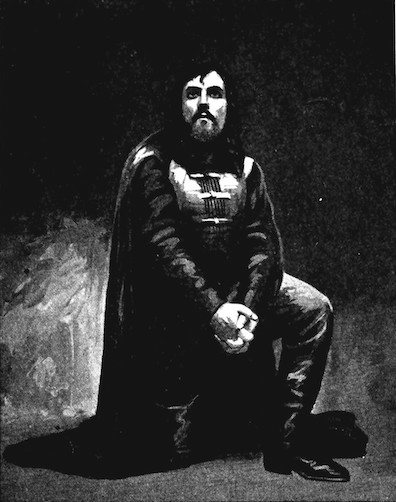
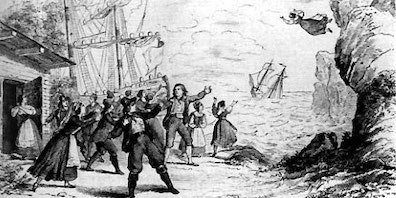

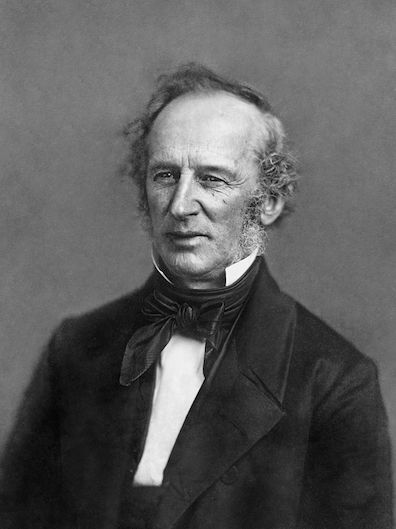 Cornelius
Vanderbilt
in a gold-toned half-plate daguerreotype produced by Matthew
Brady's studio between 1844 and 1860, held in the Library of
Congress. Source: Wikimedia Commons.
Cornelius
Vanderbilt
in a gold-toned half-plate daguerreotype produced by Matthew
Brady's studio between 1844 and 1860, held in the Library of
Congress. Source: Wikimedia Commons.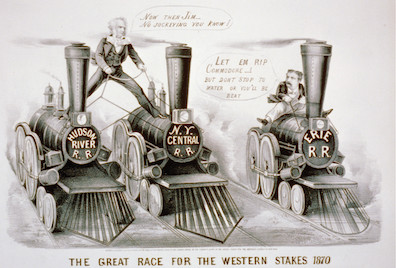 Cornelius
Vanderbilt
and James Fisk Jr. in "The Great Race for the Western Stakes,"
an 1870 Currier & Ives lithograph held in the Library of
Congress. Source: Wikimedia Commons.
Cornelius
Vanderbilt
and James Fisk Jr. in "The Great Race for the Western Stakes,"
an 1870 Currier & Ives lithograph held in the Library of
Congress. Source: Wikimedia Commons. The English
playwright Tom Taylor, in an 1863 photographic portrait by Lewis
Carroll. Source: Wikimedia Commons.
The English
playwright Tom Taylor, in an 1863 photographic portrait by Lewis
Carroll. Source: Wikimedia Commons. The
screw propeller of the Archimedes fitted in the ship's stern, as
it appeared in a drawing in the November 1843 Illustrirte
Zeitung. Source: Wikimedia Commons.
The
screw propeller of the Archimedes fitted in the ship's stern, as
it appeared in a drawing in the November 1843 Illustrirte
Zeitung. Source: Wikimedia Commons.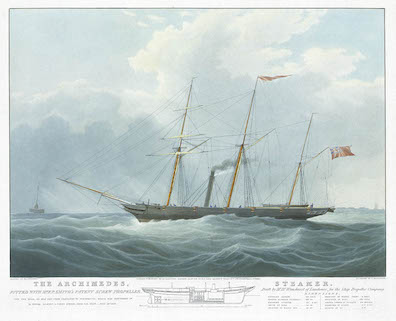 The
Archimedes proceeding under steam power from Gravesend to
Portsmouth, in an 1839 hand-colored aquatint held in the
Royal Museums Greenwich. (The text to the left of the drawn
cross-section notes that the vessel is "fitted with Mr F.P.
Smith's patent screw propeller.") Source: Wikimedia Commons.
The
Archimedes proceeding under steam power from Gravesend to
Portsmouth, in an 1839 hand-colored aquatint held in the
Royal Museums Greenwich. (The text to the left of the drawn
cross-section notes that the vessel is "fitted with Mr F.P.
Smith's patent screw propeller.") Source: Wikimedia Commons.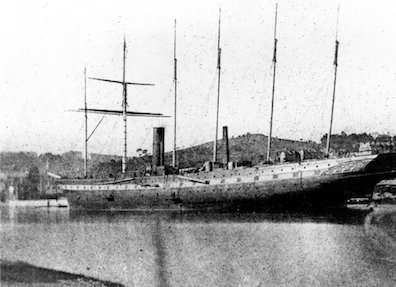 Photograph
(believed to be the first ever taken of a ship) by William Henry
Fox Talbot of the SS Great Britain fitting out along Gasworks
Quay in Bristol Floating Harbour in April 1844. Source:
Wikimedia Commons.
Photograph
(believed to be the first ever taken of a ship) by William Henry
Fox Talbot of the SS Great Britain fitting out along Gasworks
Quay in Bristol Floating Harbour in April 1844. Source:
Wikimedia Commons.